 |
Home > Fishes
> Pelagic Fishes
Updated 10/20/2020
Pelagic Fishes
Family Scombridae
Tunas &
Mackerels
| Streamlined, fast-swimming inhabitants of coastal and open
water. Tuna are warm-blooded with reddish, well-oxygenated
muscle and keep swimming to maintain sufficient flow over the
gills. A common characteristic of the family is counter-shading,
where the upper half is dark blue and the lower silvery white,
effectively hiding it from predators above and below. They feed
upon fish or squid and are in turn preyed upon by larger carnivores
including larger kin, sharks, dolphins, billfishes, and man. Many
scombrids are of great commercial importance although stocks have been
depleted in some areas. |
HAWAII
| Acanthocybium solandri

WAHOO
ONO
|
Euthynnus affinis
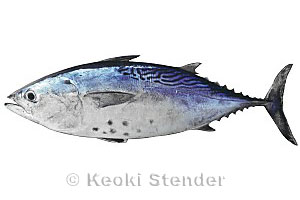
LITTLE
TUNA KAWAKAWA
|
|
Katsuwonus pelamis
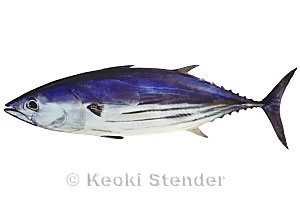
SKIPJACK TUNA
AKU
|
Thunnus alalunga

ALBACORE TOMBO
AHI
|
| Thunnus albacares
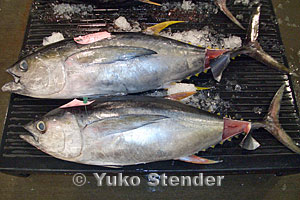
YELLOWFIN TUNA
AHI
|
Thunnus obesus
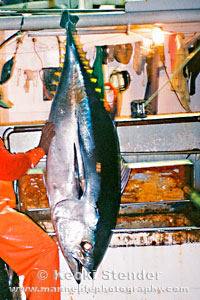
BIGEYE TUNA
AHI PO'ONUI
|
| Sarda
orientalis
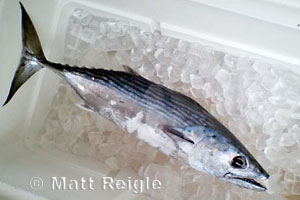
STRIPED or ORIENTAL BONITO
|
Scomber
australasicus
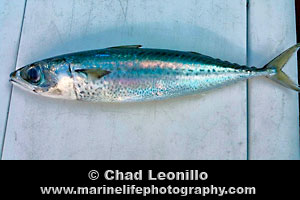
SPOTTED MACKEREL
|
|
|
INDO-PACIFIC
|
Scomberomorus commerson
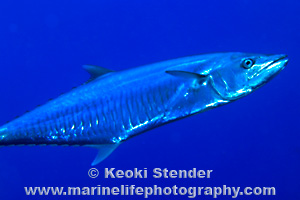
NARROW-BARRED SPANISH MACKEREL
|
Rastrelliger kanagurta
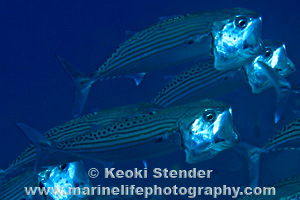
INDIAN MACKEREL
|
|
|
|
WESTERN ATLANTIC
|
Scomberomorus regalis
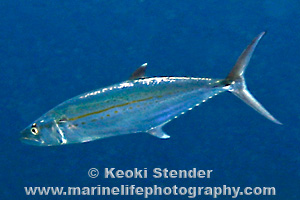
CERO
|
|
|
|
|
Family Gempylidae
Snake Mackerels
| Snake Mackerels inhabit mid-water depths of the open ocean, migrating
toward the surface at night to feed upon fishes & planktonic
invertebrates. Landed as bycatch on tuna longline
vessels. |
HAWAII
| Lepidocybium
flavobrunneum
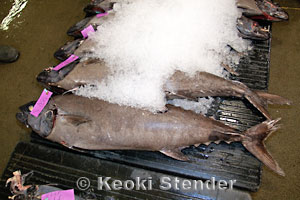
SMITH'S ESCOLAR
WALU
|
Gempylus serpens
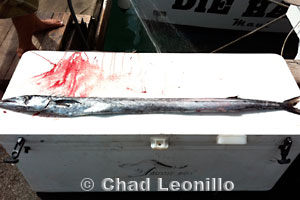
SNAKE MACKEREL
|
|
|
|
|
Family Istiophoridae
Billfishes
| True billfishes have an upper jaw roughly cylindrical in
cross-section. They inhabit well-lit surface waters of the open
sea and feed on fishes during the day. The bill is slashed left
and right to maim prey so it can be swallowed with ease. Highly sought by sport
fishers but not esteemed as food, since the flesh of most species is
tough, dry, and high in mercury. |
HAWAII
| Makaira
nigricans
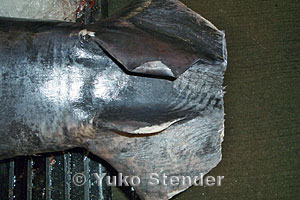
PACIFIC BLUE MARLIN Kajiki
|
Tetrapterus audax

STRIPED MARLIN NAIRAGI
|
| Istiophorus platypterus
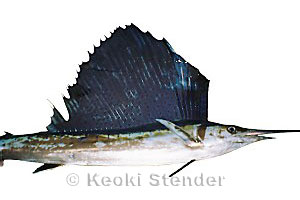
SAILFISH
|
Tetrapterus angustirostris
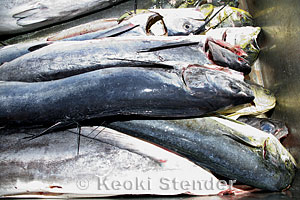
SHORTBILLED SPEARFISH
HEBI
|
|
|
|
|
Family Xiphiidae
Broadbill Swordfish
HAWAII
| Xiphias gladius
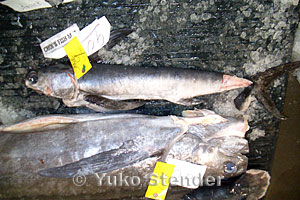
BROADBILL SWORDFISH
SHUTOME
|
|
Family Coryphaenidae
Mahimahi
HAWAII
| Coryphaena hippurus
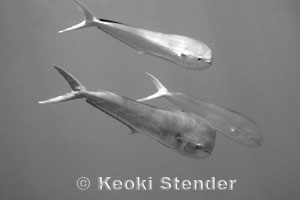
DOLPHINFISH
MAHIMAHI
|
|
Family Lampridae
Moonfish
HAWAII
| Lampris
megalopsis

BIGEYE MOONFISH OPAH
|
|
Family
Bramidae
Pomfrets
HAWAII
| Taractichthys steindachneri
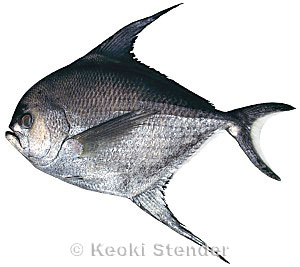
SICKLE POMFRET MONCHONG
|
Eumegistus illustris
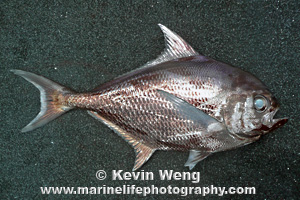
LUSTROUS POMFRET MONCHONG
|
| Brama sp.

POMFRET
|
|
Family Zeidae
Dories
HAWAII
| Zenopsis
nebulosa

MIRROR DORY
Kagamidai
|
|
|
|
Family Exocoetidae
Flyingfishes
HAWAII
| Cheilopogon spilonotopterus
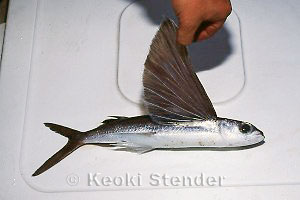
STAINED FLYINGFISH
|
Exocoetus volitans
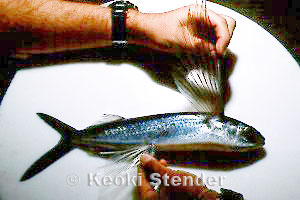
TROPICAL TWO-WINGED FLYINGFISH
|
|
Parexocoetus brachypterus
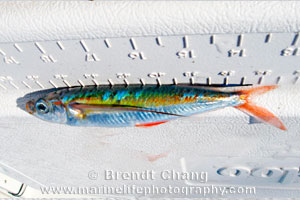
SAILFIN FLYINGFISH
|
|
|
|
|
|
EASTERN PACIFIC
| Cheilopogon
pinnatibarbatus californicus

CALIFORNIA FLYINGFISH
|
|
|
|
Family Nomeidae
Driftfishes
CIRCUMTROPICAL
| Psenes cyanophrys
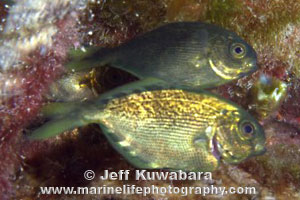
FRECKLED DRIFTFISH
|
Psenes
arafurensis
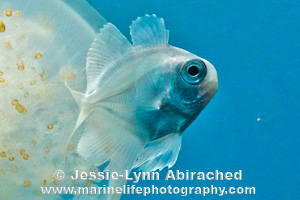
DUSKY DRIFTFISH
|
| Nomeus
gronovii
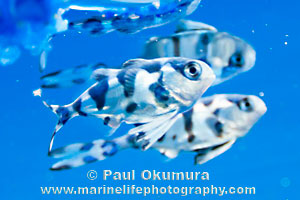
MAN-O'-WAR FISH |
Cubiceps
paradoxus
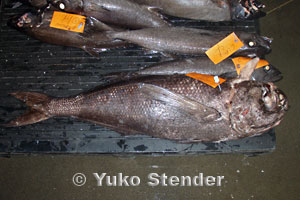
LONGFIN CIGARFISH
|
|
|
|
|
Family Myctophidae
Lanternfishes
| Lanternfishes inhabit midwater depths of the open ocean and make a
nightly migration toward the surface to feed upon zooplankton.
They employ light-emitting bacteria in special cells along the sides and
belly to create a pale green light to hide their silhouette from
predators below. They are among the most numerous animals in the
ocean. |
HAWAII
| Diaphus fragilis
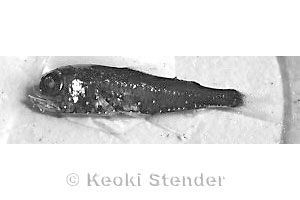
FRAGILE LANTERNFISH
|
|
|
|
Family Trichiuridae
Beltfishes
HAWAII
| Assurger anzac
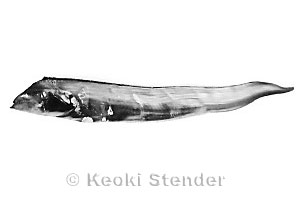
RAZORBACK SCABBARDFISH Tachiuo
|
|
|
|
Family
Echeneidae
Remoras, Sharksuckers
| Remoras are usually associated with large animals in the open
ocean. They use a special suction device on the forehead to
hitchhike on other animals to conserve energy. They feed upon scraps of food left by their host. They
might temporarily
attach themselves to vessels, swimmers or divers. |
CIRCUMTROPICAL
| Remora remora
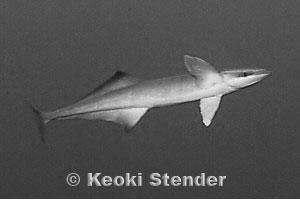
COMMON REMORA
|
Echeneis naucrates

SLENDER SHARKSUCKER
|
|
|
|





































